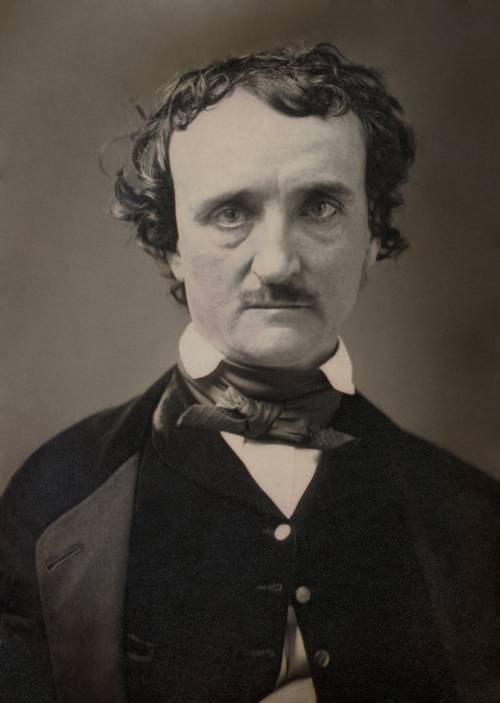
FAQ About Edgar Allan Poe

Who was Edgar Allan Poe?
Edgar Allan Poe was an American writer, poet, editor, and literary critic. He is best known for his poetry and short stories, particularly his tales of mystery and the macabre. Poe is widely regarded as a central figure in the development of romanticism in the United States and American literature as a whole. He was born on January 19, 1809, in Boston, Massachusetts, and died on October 7, 1849, in Baltimore, Maryland.

What are some of Edgar Allan Poe's most famous works?
Some of Edgar Allan Poe's most famous works include the poem "The Raven," the short story "The Tell-Tale Heart," and "The Fall of the House of Usher." His works are renowned for their exploration of themes such as death, madness, and the supernatural.

What themes are prevalent in Edgar Allan Poe's writing?
Edgar Allan Poe's writing often explores themes of death, mourning, and the macabre. These themes are frequently intertwined with elements of the supernatural, psychological horror, and existential dread. Poe also delved into themes of loss, love, and the duality of human nature, creating a rich tapestry of emotion and intrigue in his works.

Was Edgar Allan Poe considered successful during his lifetime?
During his lifetime, Edgar Allan Poe achieved some fame but struggled with financial difficulties. While he was well-known in certain literary circles and had his works published, he did not experience major financial success. His poem "The Raven," published in 1845, garnered significant attention and acclaim, but overall, he didn't attain the popularity he has today.

How did Edgar Allan Poe die?
The circumstances surrounding Edgar Allan Poe's death remain mysterious and are the subject of speculation and debate. He was found delirious on the streets of Baltimore on October 3, 1849, wearing clothes that were not his own. He died in a hospital on October 7, 1849, and the precise cause of his death is unknown. Suggestions include alcoholism, tuberculosis, heart disease, epilepsy, and even foul play.

What impact did Edgar Allan Poe have on literature?
Edgar Allan Poe had a profound impact on literature, particularly in the genres of horror, mystery, and science fiction. He is credited with inventing the detective fiction genre with his character C. Auguste Dupin, influencing writers like Arthur Conan Doyle. His works are celebrated for their gothic style, innovative use of narrative, and exploration of the human psyche.

What inspired Edgar Allan Poe's writing?
Edgar Allan Poe's writing was inspired by various factors, including his personal experiences, the loss of loved ones, and his struggles with mental health issues. Gothic literature and the Romantic movement, which emphasized emotion and individualism, also heavily influenced his work. His interest in the macabre and psychological complexity fed into his unique literary style.

Did Edgar Allan Poe write only horror stories?
No, Edgar Allan Poe did not write solely horror stories. Although he is best known for his contributions to the horror genre, Poe also wrote poetry, detective fiction, and works of science fiction. His literary style was versatile, and he experimented with different genres, providing a diverse body of work.

What was Edgar Allan Poe's first published work?
Edgar Allan Poe's first published work was a collection of poems titled "Tamerlane and Other Poems," which was released anonymously in 1827. This collection marked the beginning of his literary career, although it was not commercially successful.

Was Edgar Allan Poe married?
Yes, Edgar Allan Poe was married to Virginia Clemm, who was his first cousin. They married on May 16, 1836, when she was just 13 years old and he was 27. Their marriage was reportedly a loving one, but it was also marked by tragedy, as Virginia suffered from ill health and died of tuberculosis in 1847.

How did Edgar Allan Poe influence the detective fiction genre?
Edgar Allan Poe is considered a pioneer of detective fiction due to his creation of the character C. Auguste Dupin, who appeared in "The Murders in the Rue Morgue," "The Mystery of Marie Rogêt," and "The Purloined Letter." These stories are credited with establishing conventions used in later detective stories, such as the presentation of evidence, the concept of a brilliant detective, and the inclusion of a companion who narrates the detective's adventures, foreshadowing elements seen in Sherlock Holmes by Arthur Conan Doyle.

Did Edgar Allan Poe have any rivals or conflicts with other writers?
Edgar Allan Poe had several public conflicts with other writers and editors during his career. He was known for his scathing literary criticism and often engaged in feuds. One notable conflict was with Rufus Wilmot Griswold, an editor and anthologist who published a defamatory obituary of Poe after his death, which contributed to a negative perception of him that lasted for years.

What is "The Raven" about?
"The Raven" is a narrative poem by Edgar Allan Poe that tells the story of a man mourning the loss of his love, Lenore. As he mourns, he is visited by a mysterious raven that enters his chamber and perches above his door. The raven repeatedly utters the word "Nevermore," which exacerbates the man's despair and descent into madness. The poem explores themes of grief, loss, and the supernatural.

What is unique about Edgar Allan Poe's writing style?
Edgar Allan Poe's writing style is characterized by its gothic themes, elaborate and descriptive language, and focus on dark psychological elements. He often employed first-person narration, creating a sense of intimacy and immediacy. Poe was also known for his mastery of meter and rhyme in poetry, often using them to enhance the mood and tone of his works.

Where can I find Edgar Allan Poe's complete works?
Edgar Allan Poe's complete works are widely available online and in print. Websites like Poetry Foundation and Project Gutenberg offer free access to many of his works. Additionally, various collections and anthologies of Poe's writings can be found in bookstores and libraries.

Why are Edgar Allan Poe's works still popular today?
Edgar Allan Poe's works remain popular due to their timeless exploration of universal themes such as death, fear, and the human psyche. His ability to evoke emotion and create haunting atmospheres continues to resonate with readers. Moreover, his influence on the development of various literary genres, such as horror and detective fiction, ensures his enduring legacy.

What is the significance of Edgar Allan Poe's poem "Annabel Lee"?
"Annabel Lee" is one of Edgar Allan Poe's last complete poems, and it explores themes of eternal love and loss. The poem tells the story of a deep, unending love, tragically cut short by the death of the beloved Annabel Lee. This poem is significant because it reflects Poe's recurring themes of love transcending death and is considered one of his most personal and poignant works.

What contributions did Edgar Allan Poe make to science fiction?
Edgar Allan Poe contributed to the science fiction genre through his imaginative and groundbreaking works that explored futuristic and scientific themes. Stories like "The Conversation of Eiros and Charmion," "The Unparalleled Adventure of One Hans Pfaall," and "The Facts in the Case of M. Valdemar" include elements of space travel and speculative science, influencing later science fiction writers and establishing concepts that endure in the genre.

What challenges did Edgar Allan Poe face in his life?
Edgar Allan Poe faced numerous challenges throughout his life, including financial instability, the early death of his parents, and personal struggles with mental health and alcohol. He also experienced the loss of his wife, Virginia, to tuberculosis. These hardships often found their way into his writing, shaping the dark and complex themes he is known for.

How has Edgar Allan Poe influenced modern pop culture?
Edgar Allan Poe has significantly influenced modern pop culture through adaptations of his works in film, music, and literature. His tales have inspired countless horror and mystery stories, and references to his life and works appear in popular media, showcasing his lasting impact. Movies, television shows, and books frequently draw on his themes and narrative style, demonstrating his enduring relevance.
